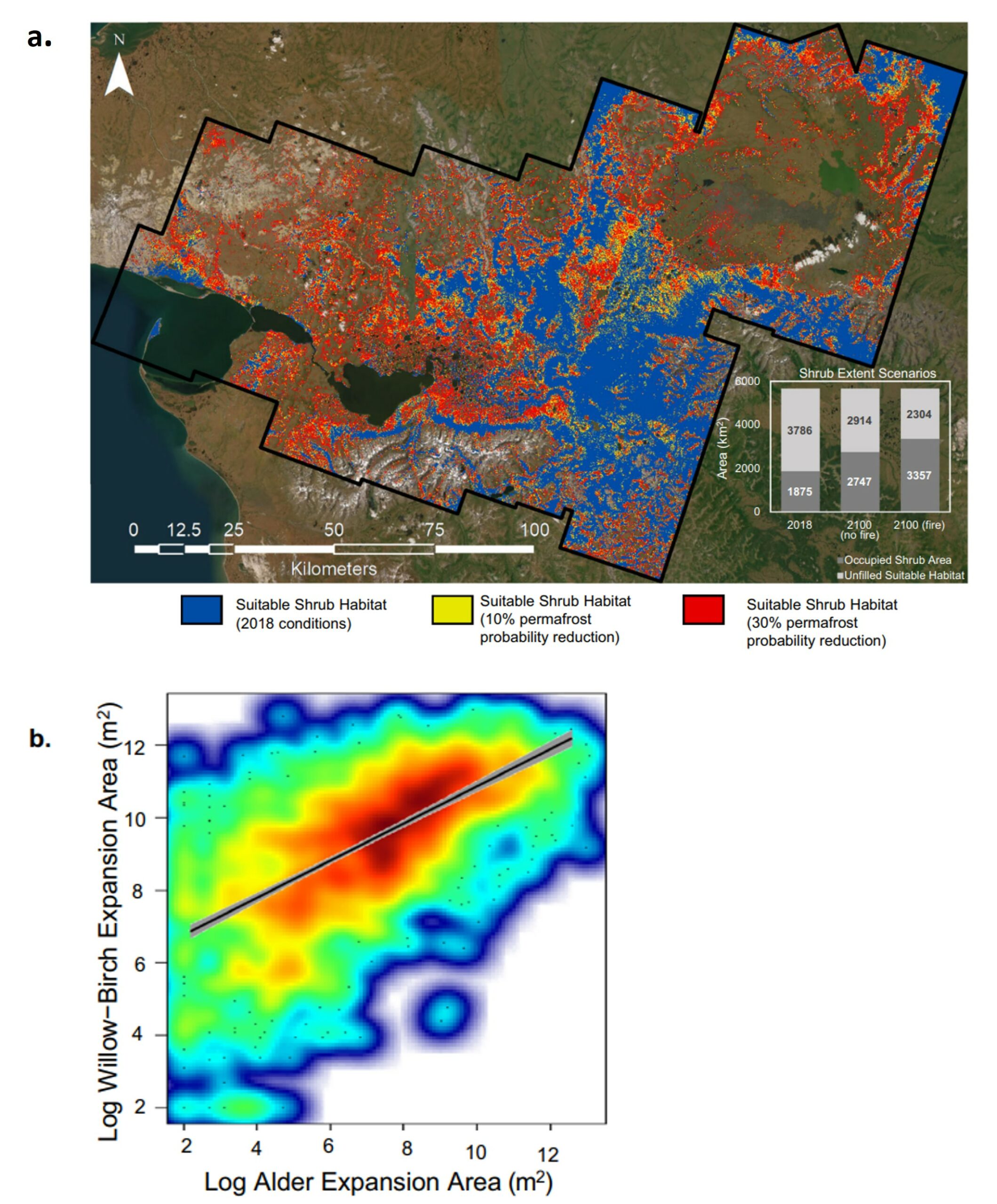November 20, 2023
Nitrogen-Fixing Shrubs Advance the Pace of Tall-Shrub Expansion in Low-Arctic Tundra
Tall shrubs are expanding their range on Alaska’s Seward Peninsula, and permafrost degradation will accelerate their continued expansion into suitable habitats.

Modeled suitable habitat for tall deciduous shrubs (a) and linear regression between willow-birch expansion and alder expansion for 1-km zones (b) in historical imagery suggest alder increases willow-birch expansion.
[Reprinted under a Creative Commons Attribution 4.0 International License (CC BY 4.0) from Schore, A. I. G., et al. "Nitrogen Fixing Shrubs Advance the Pace of Tall-Shrub Expansion in Low-Arctic Tundra." Communications Earth & Environment 4, 421 (2023). DOI:10.1038/s43247-023-01098-5.]
The Science
Researchers used fine-scale remote sensing to model tall-shrub expansion on Alaska’s Seward Peninsula over the last 68 years. The model predicted past expansion well and demonstrated suitable tall-shrub habitat is currently only one-third occupied and well-constrained by permafrost, climate, and edaphic gradients. The model also predicted increases in tall-shrub habitat driven by permafrost degradation and increased wildfire frequency. Analysis of historic imagery also revealed a positive relationship between willow-birch expansion and alder expansion, suggesting that increased nutrient availability from nitrogen-fixing alders can accelerate the rate at which tall shrubs expand into suitable habitats.
The Impact
Graminoids and short-stature shrubs have historically dominated tundra plant communities, but recent warming has caused tall shrubs to become more prevalent. A team of researchers investigated tall-shrub expansion in low-Arctic tundra by modeling past expansion of tall shrubs and predicting how and where future warming will open suitable habitats for tall shrubs. Analysis suggests that nitrogen-fixing alder will accelerate tall-shrub expansion into newly available habitat areas. Species-specific nutrient interactions are therefore important for predicting vegetation dynamics in warming, low-tundra ecosystems.
Summary
Tall deciduous shrubs are critically important to carbon and nutrient cycling in high-latitude ecosystems. As Arctic regions warm, shrubs expand heterogeneously across their ranges, including within unburned terrain experiencing isometric warming gradients. Improved knowledge of local-to-regional scale patterns, rates, and controls on decadal shrub expansion is required to constrain the effects of widespread shrub expansion in terrestrial and Earth system models.
Using fine-scale remote sensing, researchers modeled the drivers of patch-scale tall-shrub expansion over 68 years across the central Seward Peninsula of Alaska. Models show the heterogeneous patterns of tall-shrub expansion are not only predictable but have an upper limit defined by permafrost, climate, and edaphic gradients, two-thirds of which have yet to be colonized. These observations suggest that increased nitrogen inputs from nitrogen-fixing alders contributed to a positive feedback that advanced overall tall-shrub expansion. These findings will be useful for constraining and projecting vegetation-climate feedbacks in the Arctic.
Principal Investigator
Aiden Schore
University of Illinois
aschore2@illinois.edu
Co-Principal Investigator
Mark Lara
University of Illinois
mjlara@illinois.edu
Program Manager
Daniel Stover
U.S. Department of Energy, Biological and Environmental Research (SC-33)
Environmental System Science
daniel.stover@science.doe.gov
Funding
This research was supported by the National Science Foundation’s Environmental Engineering Program (EnvE-1928048) and the U.S. Department of Energy’s (DOE) Biological and Environmental Research (BER) program (DE-SC0021094). Support was also received from the Next-Generation Ecosystem Experiments Arctic project, which is funded through BER. Geospatial support for this work was provided by the Polar Geospatial Center under NSF-OPP awards 1043681 and 1559691.
References
Schore, A. I. G., et al. "Nitrogen Fixing Shrubs Advance the Pace of Tall-Shrub Expansion in Low-Arctic Tundra." Communications Earth & Environment 4 421 (2023). https://doi.org/10.1038/s43247-023-01098-5.

